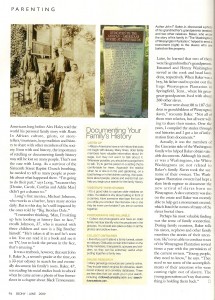Posts Tagged ‘African American History’
Tuesday, October 20th, 2009
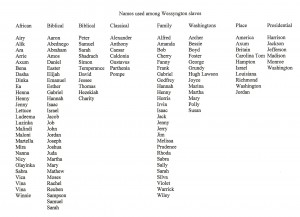
Names Among Wessyngton Slaves
African Americans got their given or first names from various sources during the slavery. Some of them used African “day names” such as Cudjo, Mingo, and Cuffee, denoting the day of the week on which they were born. Others used names from the Bible, classical names, place names, names of plantation owner’s families, famous individuals like the presidents and their own family members.
The document above lists various sources of names of individuals enslaved on Wessyngton Plantation from 1796 to 1865.
Tags:African American History, African American Names, African American slavery, African Names, Biblical Names, Day Names, Naming Practices, Slave Names
Posted in Civil War, Genealogy & DNA, Interviews, Plantation Life, Research | Comments Closed
Sunday, October 18th, 2009
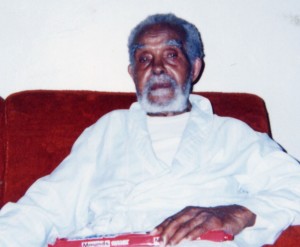
Joseph Washington 1895-2002
In more than thirty years of researching my ancestry and the lives of African Americans enslaved on Wessyngton Plantation, I have had the honor of interviewing more than twenty individuals whose parents or grandparents lived on the plantation. These individuals ranged in age from eighty to 107 years old.
Although I found hundreds of documents about my ancestors from plantation records written by the owners of Wessyngton, I learned many personal things about my ancestors from conducting interviews with elder family members.
In 1994, I visited my cousin Joseph Washington 1895-2002 (pictured above) at his home in Mansfield, Ohio on his one hundred second birthday. As a child Joseph lived next door to my great-great-grandparents Emanuel and Henny Washington who were born at Wessyngton in the early 1800s. He related many stories about them to me including ghost stories that my great-great-grandfather used to tell all the children on the plantation and songs he used to sing. Joseph told me what life was like on the plantation when he grew up there and how many people on the plantation were related to one another.
Oral history is a vital key to tracing African American genealogy and provides many details about our ancestors that can’t be found in records.
Tags:African American History, African American Oral History, African American slavery, Black Genealogy, black history, Civil War, family history, Griot, Interviews, Joseph Washington, Oral History, Oral Tradition, plantation slavery, Plantations, Tennessee history, Tennessee slavery
Posted in Civil War, Current Events, Interviews, Plantation Life, Research | Comments Closed
Friday, October 9th, 2009
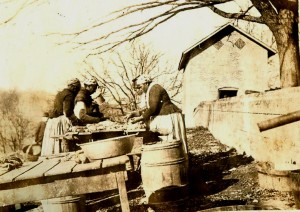
Slave Women Processing Pork on Wessyngton Plantation
Enslaved African American women performed various task on southern plantations and farms. Women on Wessyngton Plantation were not required to do any hard labor in the fields as the men did; however, they were an important part of other operations on the plantation. Women did light work in the gardens, they knitted and sewed for the slave community and their owners, worked the looms, and did the spinning and weaving. They were responsible for cooking, cleaning, washing, ironing, making cheese, preserves, and soap. No mother with a young baby was expected to do any outside work until her baby was two years old. There was a nursery on the plantation were children were cared for by elderly women too old to work. Women were a vital part of the pork processing industry on the plantation as seen in the photo above. Each week the women on the plantation would assemble at the plantation smokehouse (building in background of photo) and would be allotted bacon, meal, flour, sugar, and coffee based on the number of individuals in their families. Hundreds of hogs were killed at each year at Wessyngton to feed the enslaved population and the Washington family. Wessyngton had a reputation for producing its famous Washington Hams which could be found on the menus of the finest restaurants as far south as New Orleans and as far north as Philadelphia.
Tags:African American History, African American slavery, African American Women, Black Women during Slavery, Children in Slavery, Plantation Life, plantation slavery, Pork Production, Slave Labor, slave trade, Slave Women, Slave women in the south, Task System
Posted in Book Tour & Reviews, Civil War, Interviews, Plantation Life, Research | Comments Closed
Sunday, September 6th, 2009
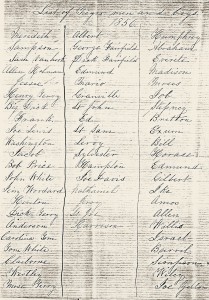
List of Men and Boys on Wessyngton Plantation 1856
Plantation owners used records such as slave bills of sales, birth registers, and many other documents to keep an accurate count of their slaves’ births, deaths, and their production on plantations and farms. These documents are invaluable in tracing African American genealogy.
The document above is a list of enslaved African American men and boys on Wessyngton Plantation in 1856 owned by George A. Washington. Slave owners had to pay taxes on their slaves from age twelve to fifty, so the list only identifies those in that age range who were a part of the plantation labor force. Many of the individuals are listed with surnames: Davis, Fairfield, Gardner, Holman, Lewis, Price, Smith, Terry, Vanhook, White and Woodard. The use of these surnames made it possible to locate them and their previous slave owners. Many of them were also found on the 1870 U. S. Census living on or near Wessyngton Plantation.
In 1964, the Washington family deposited all their family papers and plantation records in the Tennessee State Library and Archives in Nashville. Hundreds of these documents shed light on the lives of hundreds of African Americans enslaved there.
Tags:African American Genealogy, African American History, African American Surnames, Black Genealogy, Civil War, Genealogical Research, Naming Patterns, Plantation Life, Plantation Records, Roots, Slave Surnames
Posted in Civil War, Genealogy & DNA, Plantation Life, Research | Comments Closed
Tuesday, August 4th, 2009
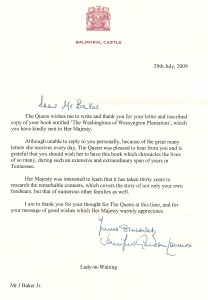
Letter from Queen Elizabeth
Queen Elizabeth acknowledged the receipt of a signed copy of my book. As is the custom, her lady-in-waiting wrote me. The royal seal indicated that the Queen was at her summer residence, Balmoral Castle in Scotland.
http://en.wikipedia.org/wiki/Balmoral_Castle– for your info.
Tags:African American History, Balmoral Castle, Buckingham Palace, Civil War, Genealogical Research, President Washington, Queen Elizabeth, Royal Family, Slavery, Tennessee history, Washington family
Posted in Civil War, Current Events, Genealogy & DNA, Interviews, Introduction & Personal, Plantation Life, Research | Comments Closed
Friday, July 24th, 2009
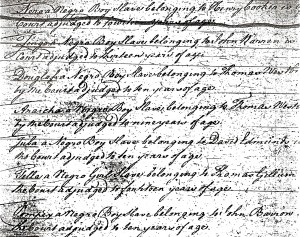
Court Orders, Southampton County, VA, 1749
Nero a Negro boy slave belonging to Henry Cooker is by the court adjudged to fourteen years of age.
Zingo a Negro boy slave belonging to John Warren by the court adjudged to thirteen years of age.
Douglas a Negro boy slave belonging to Thomas Westbrooks by the court adjudged to ten years of age.
Anarcha a Negro boy slave belonging to Thomas Westbrooks by the court adjudged to nine years of age.
Juba a Negro boy slave belonging to David Edmunds by the court adjudged to ten years of age.
Tilla a Negro girl belonging to Thomas Gillum the court adjudged to fourteen years of age.
Pompey a Negro boy slave belonging to John Barrow the court adjudged to ten years of age.
During the Colonial period, slave owners were required to pay taxes on their slaves from ages twelve to fifty years old. When Africans were brought to the colonies and it was evident that they were adults they were simply added to tax rolls called tithables. When small children and teenagers arrived from Africa and their ages were uncertain, the slave owners would have to take them into court and a judge would assign an age for the slave, which was then recorded in minute or court order books. Most of the slaves were assigned English names, although some retained their true African names. Some of the court orders also list the names of the ships the Africans arrived in and the dates of arrival. Many of these individuals can be traced in later documents such as tax records, wills, and estate settlements. These records can prove to be a genealogical goldmine for African American researchers.
Tags:Adjudgements, African American History, African History, African Names, African Roots, African Slavery, Colonial Period, Colonial Research, Colonial Tax Records, Court Orders, plantation slavery, Slave Research, Slave Ships, Slavery, Southern Plantions, Tithables, Transatlantic Slave Trade, United States History, United States slavery
Posted in Genealogy & DNA, Plantation Life, Research, Uncategorized | Comments Closed
Friday, June 5th, 2009
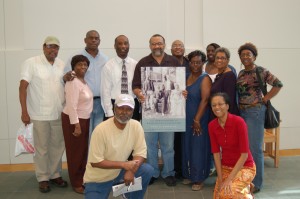
St. Louis African American History and Genealogy Society
On May 23rd I gave a presentation about my book The Washingtons of Wessyngton Plantation: Stories of My Family’s Journey to Freedom to the St. Louis African American History and Genealogy Society at the Missouri History Museum. I made many new friends among avid genealogical researchers. I had a great time in St. Louis and look forward to visiting again.
Tags:African American History, African American slavery, DNA Research, family history, family tree, Genealogical Research, Plantation Life, Washington family
Posted in Book Tour & Reviews, Current Events, Genealogy & DNA, Introduction & Personal, Plantation Life, Research | Comments Closed
Monday, May 18th, 2009
My half-hour television interview with John Seigenthaler Sr, A Word on Words, is available as a free downloadable Podcast.
http://www.wnpt.org/productions/wow/
Mr. Seigenthaler asked me many in-depth thought-provoking questions. At the end, he said, “I learned more from your book than I learned from reading my friend Alex Haley’s book called Roots.” I hope you enjoy the interview. Leave a comment with your reaction.
Tags:Abraham Lincoln, African American History, Black History Month, book review, Civil War, DNA Research, Emancipation, family history, family tree, Genealogy & DNA, George Washington, John F. Baker Jr., John Siegenthaler, plantation slavery, Reconstruction, Roots, Simon & Schuster, Tennessee slavery, Washington family, Wessyngton Plantation, WNPT, Word On Words
Posted in Book Tour & Reviews, Civil War, Current Events, Genealogy & DNA, Interviews, Introduction & Personal, Plantation Life, Research, Videos & Audios | Comments Closed
Monday, May 18th, 2009
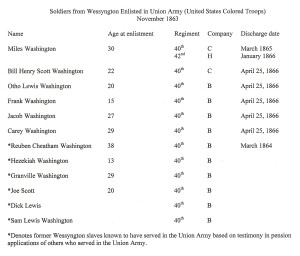
USCT from Wessyngton
On Memorial Day, we need to take a moment to tell our children about their ancestors who fought for freedom and America. During the Civil War, our ancestors fled slavery and the plantations and joined the Union Army to fight for freedom. We must never forget the sacrifices of our ancestors that we might enjoy freedom today.
Tags:African American History, August 8th, black history, Civil War, Contraband, Contraband Camps, Emancipation, Emancipation Proclamation, Freedmen, Freedmens Bureau, Ft. Negley, Ranaway Slaves, Union Army, Union Troops, United States Colored Troops
Posted in Civil War, Current Events, Genealogy & DNA, Interviews, Introduction & Personal, Plantation Life, Research | Comments Closed








